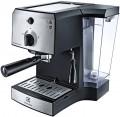Used coffee
Types of coffee for which the coffee maker was originally designed.
—
Ground. Traditional ground coffee; the easiest way is to buy such a product in finished form, but if you wish, you can grind it yourself from whole beans. And if this option is specified for a model with a built-in coffee grinder (see above), this means that both beans and pre-ground coffee can be loaded into it.
—
In grains. This option means that the coffee maker is equipped with a built-in coffee grinder by definition, which means that you can grind beans in it immediately before brewing, which allows you to maximize the taste and aroma. For more information about the other benefits of this option, see "Built-in coffee grinder". Also note here that some coffee makers with this function also allow the use of ground coffee (see above), others work exclusively with beans from their own coffee grinder and do not require loading a powder that was ground separately.
—
Capsules. Ground coffee, packaged in special capsules; usually, one such container is used to prepare one serving of the drink. Capsule coffee makers are extremely simple and easy to use: just load the capsule, turn on the making and wait for the end of the process, and then remove the used container. The capsules themselves can be both disposable and reusable. The advantage of the first option is that the human fac
...tor is eliminated from the brewing process: each capsule contains a standard portion of coffee, and each next cup is no different from the previous one. In addition, disposable containers are hermetically sealed and can be stored for a long time without loss of quality. Their disadvantages are the limited flavors, the high final cost of the drink (almost twice as expensive as using beans or ground coffee), and the fact that different manufacturers of coffee makers use different capsule formats. Reusable capsules can be refilled with ground coffee to your taste, they are cheaper, but not suitable for long-term storage and require thorough cleaning when changing coffee sorts.
— Pods (cialda). A type of portion packaging in which roasted ground coffee is packed in a special filter, most often paper; each such filter is stored in a sealed bag. From a practical point of view, pods are very similar to disposable capsules (see above). On the one hand, the preparation of such coffee is extremely simple, convenient and does not require any special skills: just load the pod, turn on the coffee maker and wait for the preparation; and sealed packaging allows you to store such coffee for a long time. But pods do not allow you to experiment with different sorts, grinding levels and preparing features, and the selection of sorts and flavors among them is rather limited. In terms of one cup of coffee in pods, it is cheaper than a drink from disposable capsules, but still more expensive than coffee from ground beans.
On a separate note some models of coffee makers allow the user to use several types of coffee at once. For example, in the holder of some manual espresso coffee makers (see "Type"), both a portion of ground coffee and a pod can be loaded.Water tank
The volume of the water tank provided in the coffee maker; for turkish electric coffee pot (see "Type"), this paragraph indicates the actual working volume of the turk.
The larger the tank, the more coffee you can make without refilling the device; on the other hand, a large capacity, respectively, affects the dimensions, weight and price of the device. Therefore, manufacturers select this parameter in accordance with the general level of the coffee maker and the features of its intended use. So, you rarely have to make more than two cups of coffee at the same time, and 300 – 400 mL for such cases is usually more than enough for home use. And for use in a coffee shop or restaurant, where coffee is made often and in large quantities,
large-sized devices are produced, the volume of which is already calculated in liters; recommendations for choosing the volume of a coffee maker for professional use can be found in special sources.
Power consumption
Power consumption of the coffee maker. Usually, this indicator is comparable with the power of the heater installed in the device.
This parameter is selected by the manufacturer, taking into account other performance characteristics (type of device, tank volume, additional functions, etc.), so that the coffee maker can effectively cope with its tasks. Therefore, in fact, power is of secondary importance: it is worth deciding first of all on other practical points, and only then look at power when choosing. In general, a more powerful coffee maker (ceteris paribus) will quickly cope with the preparation of coffee, but it will also cost more.

